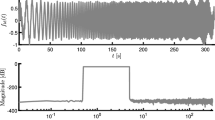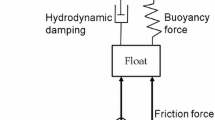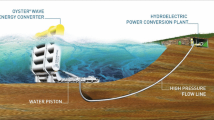Abstract
Wave energy converters (WECs) inherently require appropriate control system technology to ensure maximum energy absorption from ocean waves, consequently reducing the associated levelised cost of energy and facilitating their successful commercialisation. Regardless of the control strategy, the definition of the control problem itself depends upon the specification of a suitable WEC model. Not only is the structure of the model relevant for the definition of the control problem, but also its associated complexity: given that the control law must be computed in real-time, there is a limit to the computational complexity of the WEC model employed in the control design procedure, while there is also a limit to the (analytical) complexity of mathematical models for which a control solution can be efficiently found. This paper presents a systematic nonlinear model reduction by moment-matching framework for WEC systems, capable of providing control-oriented WEC models tailored for the control application, which inherently preserves steady-state response characteristics. Existence and uniqueness of the associated nonlinear moment for WECs are proved in this paper, for a general class of systems. Given that the definition of nonlinear moments depends upon the solution of a nonlinear partial differential equation, an approximation framework for the computation of the nonlinear moment is proposed, tailored for the WEC application. Finally, the use and capabilities of the framework are illustrated by means of case studies, using different WEC systems, under a variety of wave conditions.














Similar content being viewed by others
Notes
Linear conditions refers to so-called linear potential flow theory, see [13].
Within the field of wave energy applications, internal stability is a fundamental requirement of a model representing the physical system not only for control/estimation, but also for motion simulation and power assessment purposes.
Assuming that the nonparametric nature of \(\varSigma \) is only due to linear radiation dynamics. This is not always necessarily the case, since \(f_{\text {nl}}\) can be potentially nonparametric.
From now on, the dependence on t is dropped when clear from the context.
Let \(A\in \mathbb {R}^{n\times n}\). An eigenvalue \(a\in \lambda (A)\) is said to be simple if its algebraic multiplicity is equal to 1.
All statements are local, although global versions can be straightforwardly derived.
Throughout this manuscript, if a given system \(\varSigma \) is reduced by moment-matching to a system \({\tilde{\varSigma }}\), \(\varSigma \) and \({\tilde{\varSigma }}\) are referred to as the target and approximating systems, respectively.
See [13] for the definition of \(A(\omega )\).
The interested reader is referred to [42] for further detail on this class of integro-differential operators.
Practical implications of both \({\mathbf {f}}\) and T (or, equivalently, \(\omega _0\)) in our model reduction framework, are discussed in detail in Sect. 8.1.
This claim, which directly relates to Jacobian analysis, is considered standard in nonlinear dynamics. Further detail can be found in, for instance, [20, Chapter 8].
The extension to multiple trajectories presented in this section is proposed in the spirit of the so-called \({\mathscr {U}}/{\mathscr {X}}\) variation [35].
The mapping \(f^{\text {nl}}_{\text {re}}\) is geometry dependent and, for the spherical heaving point absorber case, can be found in, for instance, [25].
A small time-step is selected (with respect to the dominant system dynamics) to guarantee convergence in the benchmark response.
The approach presented herein is simply one possibility: The user is free to select a finite set of initial conditions using different methods, according to specific application requirements.
The use of the term ‘amplitude’ for \(A_p\) is justified in Remark 27.
This is considered to simplify the case study, and focus on the performance of the nonlinear reduction technique.
Computed randomly according to the SDF of Fig. 8.
The methodology employed herein uses random amplitudes. The reader is referred to [24] for further detail.
Ratio between the time required to compute the output of each corresponding model, and the length of the simulation itself. The computations are performed using Matlab®, running on a PC composed of an Intel Core i7-5550U processor with 8GB of RAM.
References
Astolfi, A.: Model reduction by moment matching for linear and nonlinear systems. IEEE Trans. Autom. Control 55(10), 2321–2336 (2010)
Aubin, J.P.: Applied Functional Analysis, vol. 47. Wiley, Hoboken (2011)
Bacelli, G., Genest, R., Ringwood, J.V.: Nonlinear control of flap-type wave energy converter with a non-ideal power take-off system. Ann. Rev. Control 40, 116–126 (2015)
Boyd, J.P.: Chebyshev and Fourier Spectral Methods. Courier Corporation, North Chelmsford (2001)
Bretschneider, C.L.: Wave variability and wave spectra for wind-generated gravity waves. Technical report 118, Beach Erosion Board, US Army, Corps of Engineers (1959)
Coleman, T.F., Li, Y.: An interior trust region approach for nonlinear minimization subject to bounds. SIAM J. Optim. 6(2), 418–445 (1996)
Cummins, W.: The impulse response function and ship motions. Technical report, DTIC Document (1962)
Faedo, N., Olaya, S., Ringwood, J.V.: Optimal control, MPC and MPC-like algorithms for wave energy systems: an overview. IFAC J. Syst. Control 1, 37–56 (2017)
Faedo, N., Peña-Sanchez, Y., Ringwood, J.V.: Finite-order hydrodynamic model determination for wave energy applications using moment-matching. Ocean Eng. 163, 251–263 (2018)
Faedo, N., Peña-Sanchez, Y., Ringwood, J.V.: Parametric representation of arrays of wave energy converters for motion simulation and unknown input estimation: a moment-based approach. Appl. Ocean Res. 98, 102055 (2020)
Faedo, N., Scarciotti, G., Astolfi, A., Ringwood, J.V.: Moment-based constrained optimal control of an array of wave energy converters. In: 2019 American Control Conference (ACC), Philadelphia, pp. 4797–4802 (2019)
Faedo, N., Scarciotti, G., Astolfi, A., Ringwood, J.V.: Nonlinear energy-maximising optimal control of wave energy systems: a moment-based approach. IEEE Trans. Control Syst. Technol. (under review) (2020)
Falnes, J.: Ocean waves and oscillating systems: linear interactions including wave-energy extraction. Cambridge University Press, Cambridge (2002)
Finlayson, B., Scriven, L.: The method of weighted residuals—a review. Appl. Mech. Rev. 19(9), 735–748 (1966)
Garcia-Rosa, P.B., Lizarralde, F., Estefen, S.F.: Optimization of the wave energy absorption in oscillating-body systems using extremum seeking approach. In: 2012 American Control Conference (ACC), pp. 1011–1016. IEEE (2012)
Giorgi, G.: Nonlinear hydrodynamic modelling of wave energy converters under controlled conditions. Ph.D. thesis, Department of Electronic Engineering, Maynooth University (2018)
Giorgi, G., Gomes, R.P., Bracco, G., Mattiazzo, G.: Numerical investigation of parametric resonance due to hydrodynamic coupling in a realistic wave energy converter. Nonlinear Dyn. 101(1), 153–170 (2020)
Giorgi, G., Ringwood, J.V.: Consistency of viscous drag identification tests for wave energy applications. In: Proceedings of the 12th European Wave and Tidal Energy Conference (EWTEC). Cork (2017)
Hasselmann, K.: Measurements of wind wave growth and swell decay during the Joint North Sea Wave Project (JONSWAP). Dtsch. Hydrogr. Z. 8, 95 (1973)
Isidori, A.: Nonlinear Control Systems. Springer, Berlin (2013)
Isidori, A., Astolfi, A.: Disturbance attenuation and \(h_{\infty }\)-control via measurement feedback in nonlinear systems. IEEE Trans. Autom. Control 37(9), 1283–1293 (1992)
Kautsky, J., Nichols, N.K., Van Dooren, P.: Robust pole assignment in linear state feedback. Int. J. Control 41(5), 1129–1155 (1985)
Korde, U.A., Ringwood, J.V.: Hydrodynamic Control of Wave Energy Devices. Cambridge University Press, Cambridge (2016)
Mérigaud, A., Ringwood, J.V.: Free-surface time-series generation for wave energy applications. IEEE J. Ocean. Eng. 43(1), 19–35 (2018)
Nielsen, S.R., Zhou, Q., Kramer, M.M., Basu, B., Zhang, Z.: Optimal control of nonlinear wave energy point converters. Ocean Eng. 72, 176–187 (2013)
Padoan, A., Scarciotti, G., Astolfi, A.: A geometric characterization of the persistence of excitation condition for the solutions of autonomous systems. IEEE Trans. Autom. Control 62(11), 5666–5677 (2017)
Papillon, L., Costello, R., Ringwood, J.V.: Boundary element and integral methods in potential flow theory: a review with a focus on wave energy applications. J. Ocean Eng. Mar. Energy 6, 303–337 (2020)
Peña-Sanchez, Y., Faedo, N., Ringwood, J.V.: Moment-based parametric identification of arrays of wave energy converters. In: 2019 American Control Conference (ACC), pp. 4785–4790. IEEE (2019)
Penalba, M., Ringwood, J.V.: Linearisation-based nonlinearity measures for wave-to-wire models in wave energy. Ocean Eng. 171, 496–504 (2019)
Penalba Retes, M., Ringwood, J.V.: Systematic complexity reduction of wave-to-wire models for wave energy system design. Ocean Eng. Accepted June 2020 (2020)
Pierson Jr., W.J., Moskowitz, L.: A proposed spectral form for fully developed wind seas based on the similarity theory of sa kitaigorodskii. J. Geophys. Res. 69(24), 5181–5190 (1964)
Rao, K.R., Kim, D.N., Hwang, J.J.: Fast Fourier Transform-Algorithms and Applications. Springer, Berlin (2011)
Ringwood, J.V., Bacelli, G., Fusco, F.: Energy-maximizing control of wave-energy converters: the development of control system technology to optimize their operation. IEEE Control Syst. 34(5), 30–55 (2014)
Ruehl, K., Bull, D.: Wave energy development roadmap: design to commercialization. In: OCEANS 2012 MTS/IEEE: Harnessing the Power of the Ocean (2012)
Scarciotti, G., Astolfi, A.: Data-driven model reduction by moment matching for linear and nonlinear systems. Automatica 79, 340–351 (2017)
Scarciotti, G., Astolfi, A.: Nonlinear model reduction by moment matching. Found. Trends Syst. Control 4(3–4), 224–409 (2017)
Scruggs, J., Lattanzio, S., Taflanidis, A., Cassidy, I.: Optimal causal control of a wave energy converter in a random sea. Appl. Ocean Res. 42, 1–15 (2013)
Suchithra, R., Ezhilsabareesh, K., Samad, A.: Development of a reduced order wave to wire model of an owc wave energy converter for control system analysis. Ocean Eng. 172, 614–628 (2019)
Sun, Z., Zhao, A., Zhu, L., Lu, K., Wu, W., Blaabjerg, F.: Extremum-seeking control of wave energy converters using two-objective flower pollination algorithm. In: 2018 IEEE International Power Electronics and Application Conference and Exposition (PEAC), pp. 1–5. IEEE (2018)
Taghipour, R., Perez, T., Moan, T.: Hybrid frequency-time domain models for dynamic response analysis of marine structures. Ocean Eng. 35(7), 685–705 (2008)
Urabe, M.: Galerkin’s procedure for nonlinear periodic systems. Arch. Ration. Mech. Anal. 20(2), 120–152 (1965)
Wazwaz, A.M.: Volterra integro-differential equations. In: Linear and Nonlinear Integral Equations, pp. 175–212. Springer (2011)
Wendt, F., Nielsen, K., Yu, Y.H., Bingham, H., Eskilsson, C., Kramer, M., Babarit, A., Bunnik, T., Costello, R., Crowley, S., et al.: Ocean energy systems wave energy modelling task: modelling, verification and validation of wave energy converters. J. Mar. Sci. Eng. 7(11), 379 (2019)
Zhou, K., Doyle, J.C.: Essentials of Robust Control, vol. 104. Prentice Hall, Upper Saddle River (1998)
Acknowledgements
This work was supported by the Science Foundation Ireland under Grant No. SFI/13/IA/1886. The authors are grateful with Prof. Alessandro Astolfi and Dr. Giordano Scarciotti from the Control and Power Group, Imperial College London, for useful discussions on nonlinear moment-based theory.
Author information
Authors and Affiliations
Corresponding author
Ethics declarations
Conflict of interest
The authors declare that they have no conflict of interest.
Additional information
Publisher's Note
Springer Nature remains neutral with regard to jurisdictional claims in published maps and institutional affiliations.
Rights and permissions
About this article
Cite this article
Faedo, N., Dores Piuma, F.J., Giorgi, G. et al. Nonlinear model reduction for wave energy systems: a moment-matching-based approach. Nonlinear Dyn 102, 1215–1237 (2020). https://doi.org/10.1007/s11071-020-06028-0
Received:
Accepted:
Published:
Issue Date:
DOI: https://doi.org/10.1007/s11071-020-06028-0




